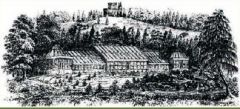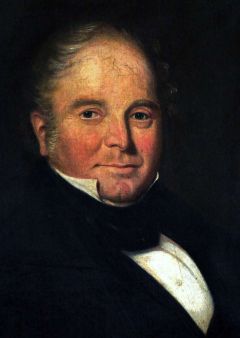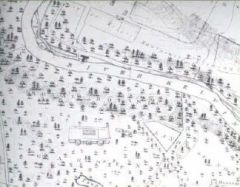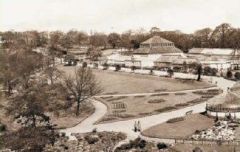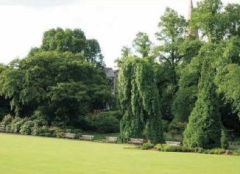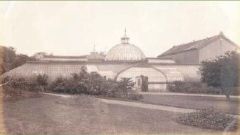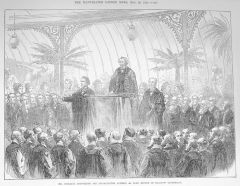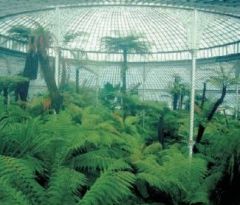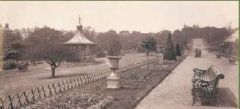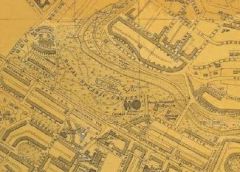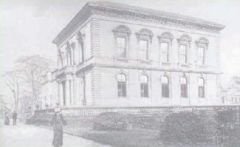History of Glasgow Botanic Gardens
Glasgow Botanic Gardens have had a varied history. They evolved from a Physic Garden established in the grounds of the old College in 1705, for teaching purposes and maintained for about one hundred years. The Gardens were ultimately re-established in the West End in May 1817, when the work of laying out a botanic garden was begun on an eight acre site at Sandyford, at the west end of Sauchiehall Street
This site was acquired by Thomas Hopkirk who founded the Royal Botanic Institution of Glasgow. The Institution managed the Gardens until they were taken over by the Corporation in 1891.
Funds were raised by public subscription, and the University made a substantial contribution on the understanding that a room was set aside for the Professor of Botany to deliver lectures, and that plant material for the students was also supplied by the gardens. In 1818 the Crown gave a donation and also granted a Royal Charter. Also in that year the University appointed the first Regius Professor of Botany, Dr Robert Graham, and he took an active part in the formation of the new Gardens. Hopkirk gifted the plants cultivated in his own garden at Dalbeth to form the nucleus of the new Botanic Gardens.
William Jackson Hooker, one of the most outstanding of British botanists. was appointed to the chair of Botany at Glasgow in 1821. He was largely responsible for the remarkable success of the Gardens in the early years. This was a period when many new plants were being introduced into cultivation and Hooker carried out much of the work on the description of these species, and the publication of botanical drawings of them. It was mainly due to his work that within ten years of its foundation Glasgow Botanic Gardens already had a prominent position in the world of botany.
The rapid expansion of Glasgow soon made the small eight acre site at Sandyford unsuitable and by 1839 an area had been purchased in the newly opened estate of Kelvinside. Sir Joseph Paxton (1803-65) was commissioned to design a new garden on the lands on the south bank of the gorge section of the River Kelvin.
The crucial years of transfer to the Kelvinside site were the peak of Stewart Murray's long and distinguished career as the first Curator of the Botanic Garden. In part the structure of the Gardens we know today was laid down by him.
This plan taken from the 1842 map by R. Manin shows the original layout planned by Stewart Murray.
Murray was born in Aberdeenshire in April 1790. Little is known of his early years, but by the time he was 17 he was in Glasgow. As a gardener at nearby Dalbeth he was much involved with Thomas Hopkirk1s plant collection and he was appointed Curator of the new Botanic Garden in 1817. As well as being a skilled and knowledgeable plantsman, Murray was a landscape designer of some note. Not only was the layout of both Botanic Gardens principally his but he was closely involved in the layout of the Glasgow Necropolis and he designed and laid out the cemeteries at Sighthill, Glasgow, and at Paisley and Greenock. After retiring in 1852 he continued as Consulting Curator.
The present Botanic Gardens were laid out and the collection transferred along with the original range of glasshouses. The only plant from the old Garden known to be in the collection today is a Weeping Ash tree which can be seen to the south of the main lawn.
The move was completed in 1842 and the Gardens then opened to members of the Royal Botanical lnstitution and their families for an annual subscription of one guinea. Later the public were admitted on selected days for the sum of one penny. Glasgow Corporation took over full ownership of the Botanic gardens in 1891 and since that time the grounds and glasshouses have opened daily free of charge to all visitors.
The jewel in the crown of structures within the Gardens is undoubtedly the Kibble Palace, by John Kibble.
Some controversy surrounds the Kibble Palace as it became known, as Sir Joseph Paxton was credited with its design and. as an engineer, John Kibble would have been familiar with Paxton's other work and his association with the Crystal Palace.
John Kibble had the glasshouse built as a conservatory at his home in Coulport on Loch Long.
Kibble offered the structure to Glasgow for erection in Queen's Park, but, when the city dithered, he withdrew his offer and it was moved to its present site in 1873, following an agreement between himself and the Royal Botanic Institution. The agreement was to run for twenty one years and involved an annual payment which became a serious burden to the Institution within a few years. In 1881, as a result of a loan of £25,000 granted by the Corporation of Glasgow, the Institution was able to buy out the lease for £10,000.
The conservatory was dismantled at Coulport in May 1872 and brought to the Gardens via Bowling on the lower reaches of the River Clyde, and up the Forth and Clyde Canal to Port Dundas. It was re-erected, with considerable extensions, by James Boyd and Sons of Paisley.
In 1874 the Kibble Crystal Art Palace and Conservatory as it was then known, had 39 statues as advertised in Tweed's Guide to Glasgow of 1874.
This image of the Kibble taken in 1875 shows the large hall erected for John Kibbles oxy-hydrogen lantern performances.It was entered from the central corridor. Kibbles' intention was to use the building for concerts and public meetings, this continued for about ten years during which time many large meetings took place. The American Evangelists, Moody and Sankey, preached to a crowd of several thousand people outside the Kibble Palace. Both Benjamin Disraeli and William Ewart Gladstone were installed as Lord Rectors of the University of Glasgow in 1873 and 1879, and delivered their Rectorial addresses in the Kibble Palace.
From the 18801s the Kibble was planted up with temperate plants including an important collection of tree ferns from the southern hemisphere.
To this day John Kibble has been the only person to Bicycle across Loch Long on floats.
In 1875 an ornamental iron bandstand was erected on the lawn in front of the Main Range of Glasshouses.
The Band of Prince Albert's Light Infantry were first to perform here on 4 August 1875. By 1912 a new pavilion style band-stand was constructed on the site now occupied by the World Rose Garden. This was used for military and local brass bands, and children's entertainment of the seaside type. These provided a moral boost during the two World Wars but by the late 1950's they were attracting little public interest. Sadly the bandstand was demolished in 1965.
The loan from the Corporation was also intended for the rebuilding of the Main Range Glasshouses, which was by this time in a serious state of disrepair, having come from the old site. The new range of houses was built on the same site and opened in early 1883.
The taking of this loan proved a fateful point of history of the Institution. By 1885 the financial position had become critical, but rather than sell up the Gardens, the Institution wished to maintain what had been built up for the City and so made moves in favour of the Corporation taking over. On 1st April 1887 Glasgow Corporation entered into possession as creditors and the Gardens were closed, maintenance work continued at the Corporations expense.
The City of Glasgow Act 1891, provided that, 'the gardens and the property and effects of the Botanic Institution should be transferred to and vested in the Corporation, to be kept open, preserved and maintained as a public area and botanic gardens for all time', and also to continue the privileges of the University for the teaching of botany. Thus the original intentions of the founders have been safeguarded, and the position of the Gardens in the lie ofthe City has been maintained.
This 1890 map of the Botanic Gardens shows how the gardens extended east of the current Queen Margaret Drive into the neighbouring North Park Estate which originally belonged to John Hamilton, who was thrice Lord Provost of the city.
North Park House (the former BBC Scotland Building) was purchased in 1882 by Mrs Isabella Elder (1828- 1905) wife of the famous John Elder one of the founder members of the Fairfield Shipyard in Govan. She had the house converted in 1883 into a college for women named after Queen Margaret (1046-1093), the wife of Scottish King Malcolm Canmore King Malcolm Ill) (1031-1093).
The College was unique in Scotland as a Women's College that offered university level teaching in both arts and medicine. In 1892 Queen Margaret College became part of the University of Glasgow and all teaching was transferred to Gilmorehill in 1935. By the 1920's the new Queen Margaret Drive and Bridge were constructed resulting in this section of the gardens being lost
